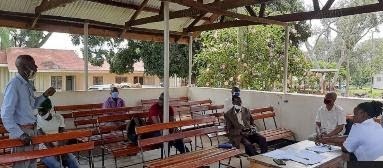The Importance of Engaging Community Influencers to Address Gender Barriers and End All Forms of GBV Against Women
By: Martin Muhire, Senior Gender and Youth Advisor

The WI-HER team engaged the USAID funded Regional Health Integration to Enhance Services in Eastern Uganda (RHITES-E) to support Uganda’s Ministry of Health and work with health facilities to identify and address community-based gender barriers that affect health behaviors. The overall goal of this activity was to increase utilization of health services and, in turn, improve the overall health of the community.
The Gender, Youth, and Social Inclusion (GYSI) team at RHITES-E recommended two health facilities: Nagongera and Malanga HC IV. Working with the District Technical Officer and the entire GYSI team for RHITES-E, WI-HER engaged health facility teams to understand what gender barriers existed in the community with a particular focus on factors that limited men and children from adhering to clinic appointments and antiretroviral therapy (ART) medication. Throughout this activity, WI-HER implemented the results-oriented methodology known as iDARE.
First, we jointly planned with the facility team to meet with caretakers of children who were on ART and who were virally non suppressed. At this initial meeting, we asked them, for example, the reasons why children did not come to their clinic appointments or why children did not take their medicines. As the interview process got underway, nearly all caretakers told us that a lack of food was a significant issue for their families. Upon further probing and more questions related to family dynamics, they shared with us issues related to communications, particularly between husband and wife; this became an opener to sharing and discussing gender-related barriers that existed within their families.
These discussions revealed some incidents of gender-based violence (GBV) that influenced the uptake of health care by men, women, and children alike. One caretaker revealed, for example, that her husband denied them access to food, which led the mother to stop giving the child medicine. For another family, disagreements between the wife and husband sometimes ended in fights, which caused one child to stop taking medication, run away from home, and get married at 14 years old. Another caretaker was beaten up every time she reminded her husband to take ART, and the husband responded with abuses like, “you die like your parents died of HIV.”
Following these responses, we asked the caretakers who in the community they trusted, could listen to, or could help them deal with issues related to GBV. As a result, we found a few community leaders who were later co-opted to the “iDARE improvement team.” They were chosen as they were seen as key community influencers for health care. This team included a representative from the: cultural leaders, religious leaders, HIV clients, teachers, and the youth. As a part of the iDARE team, each member agreed to engage their communities to create awareness about GBV, and they shared the outcome of field visits over the phone or in person at the next team meeting.
Follow-up meeting
During the follow-up meeting, each iDARE team member shared updates. One of the presentations was led by a teacher who discussed how GBV had increased during COVID-19 with wives and husbands fighting often. The teacher shared a testimony of his own; following our initial engagement, he met his son and his wife and talked about the frequent fights they had. The woman was pregnant and revealed that she was afraid of attending antenatal care (ANC) for fear of being beaten by the husband. He explained to them about the benefits of ANC. The following day, the two scheduled an appointment and visited the health center for ANC, and the husband has since vowed to support his wife in everything.
In understanding the gender-related barriers to health care, and engaging community influencers, we are better able to make deliberate efforts to address GBV and in turn achieve better health outcomes for all.